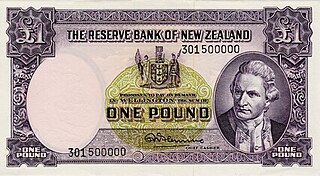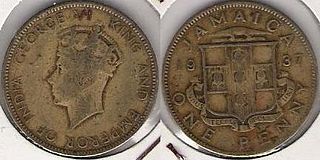
The shilling is a historical coin, and the name of a unit of modern currencies formerly used in the United Kingdom, Australia, New Zealand, other British Commonwealth countries and Ireland, where they were generally equivalent to 12 pence or one-twentieth of a pound before being phased out during the 1960s and 1970s.

The Australian dollar is the official currency and legal tender of Australia, including all of its external territories, and three independent sovereign Pacific Island states: Kiribati, Nauru, and Tuvalu. In April 2022, it was the sixth most-traded currency in the foreign exchange market and as of Q4 2023 the seventh most-held reserve currency in global reserves.

Pound is the name of various units of currency. It is used in some countries today and previously was used in many others. The English word "pound" derives from the Latin expression lībra pondō, in which lībra is a noun meaning 'pound' and pondō is an adverb meaning 'by weight'. The currency's symbol is '£', a stylised form of the blackletter 'L', crossed to indicate abbreviation.

The pound was the currency of Australia from 1910 until 14 February 1966, when it was replaced by the Australian dollar. Like other £sd currencies, it was subdivided into 20 shillings, each of 12 pence.

The Fijian dollar has been the currency of Fiji since 1969 and was also the currency between 1867 and 1873. It is normally abbreviated with the dollar sign $, or alternatively FJ$ to distinguish it from other dollar-denominated currencies. It is divided into 100 cents.

The Guyanese dollar has been the unit of account in Guyana since 29 January 1839. Originally it was intended as a transitional unit to facilitate the changeover from the Dutch guilder system of currency to the British pound sterling system. The Spanish dollar was already prevalent throughout the West Indies in general, and from 1839, the Spanish dollar unit operated in British Guiana in conjunction with British sterling coins at a standard conversion rate of one dollar for every four shillings and twopence. In 1951 the British sterling coinage was replaced with a new decimal coinage which was simultaneously introduced through all the British territories in the Eastern Caribbean. When sterling began to depreciate in the early 1970s, a switch to a US dollar peg became increasingly attractive as an anti-inflationary measure and the Eastern Caribbean Currency Authority made the switch in October 1975. The Guyanese dollar is normally abbreviated with the dollar sign $, or alternatively G$ to distinguish it from other dollar-denominated currencies.
The Saint Helenapound is the currency of the Atlantic islands of Saint Helena and Ascension, which are constituent parts of the British Overseas Territory of Saint Helena, Ascension and Tristan da Cunha. It is fixed at parity with sterling, and so both currencies are commonly accepted and circulated within Saint Helena. It is subdivided into 100 pence.
The pound is the currency of the Falkland Islands, a British Overseas Territory in the South Atlantic Ocean. The symbol is the pound sign, £. The ISO 4217 currency code is FKP.

The Solomon Islands dollar is the currency of Solomon Islands since 1977. Its symbol is $, with SI$ used to differentiate it from other currencies also using the dollar sign. It is subdivided into 100 cents.

The pound was the currency of New Zealand from 1933 until 1967, when it was replaced by the New Zealand dollar. Prior to this, New Zealand used the pound sterling since the Treaty of Waitangi in 1840. Like the pound sterling, it was subdivided into 20 shillings each of 12 pence.

The pound was the currency of Southern Rhodesia from 1964 to 1965 and Rhodesia from 1965 until 1970. It was subdivided into 20 shillings, each of 12 pence.
The Tuvaluan dollar is one of the currencies of Tuvalu, whose unofficial international currency code is TVD. Tuvalu has never had banknotes of its own, and has been issuing coins since 1976. However, the Tuvaluan dollar is used as a unit of account, and is pegged to the Australian dollar at parity. From 1966 to 1976, Tuvalu officially used the Australian dollar. In 1976, Tuvalu began issuing its own coins, which continue to circulate alongside Australian coins. Tuvalu continues to use Australian banknotes. Tuvaluan coins are not legal tender in Australia. Similar to the Faroese króna's relationship to the Danish krone and the Panamanian balboa's relationship to the United States dollar, the Tuvaluan dollar is not an independent currency, but a variation of the Australian dollar.

The pound was the official currency of Jamaica between 1840 and 1969. It circulated as a mixture of sterling coinage and locally issued coins and banknotes and was always equal to the pound sterling. The Jamaican pound was also used in the Cayman and Turks and Caicos Islands.

The Kiribati dollar is one of the two official currencies of Kiribati. The Kiribati coins are pegged at 1:1 ratio to the Australian dollar, the other official currency of Kiribati. Kiribati coins were issued in 1979 and circulate alongside banknotes and coins of the Australian dollar. In present day, Kiribati coins are rare in comparison to Australian coins with the last minor emission made in 1992, and these old coins are now generally collectors items. The complete emissions of coins were made in 1979 and in 1989 for the tenth anniversary of independence.
The pound was the currency of the Bahamas until 1966. It was equivalent to the pound sterling and was divided into 20 shillings, each of 12 pence. Standard sterling coinage circulated. Apart from a Bahamas penny coin struck in 1806, there were no special coin issues such as were found in Jamaica.

The pound was the currency of Fiji between 1873 and 1969. It was subdivided into 20 shillings, each of 12 pence.
The pound was the currency of Western Samoa between 1914 and 1967. It was subdivided into 20 shillings, each of 12 pence.
British involvement in the Middle East began with the General Maritime Treaty of 1820. This established the Trucial States and the nearby island of Bahrain as a base for suppressing sea piracy in the Persian Gulf. Meanwhile, in 1839 the British East India Company established an anti-piracy station in Aden to protect British shipping that was sailing to and from India. Involvement in the region expanded to Egypt in 1875 because of British interests in the Suez Canal, with a full scale British invasion of Egypt taking place in 1882. Muscat and Oman became a British Protectorate in 1891, and meanwhile Kuwait was added to the British Empire in 1899 because of fears surrounding the proposed Berlin-Baghdad Railway. There was a growing concern in the United Kingdom that Germany was a rising power, and about the implications that the proposed railway would have as regards access to the Persian Gulf. Qatar became a British Protectorate in 1916, and after the First World War, the British influence in the Middle East reached its fullest extent with the inclusion of Palestine, Transjordan and Iraq.
Sterling was the currency of many, but not all parts of the British Empire. This article looks at the history of sterling in the Australia, New Zealand, and Pacific region.
The United Kingdom possesses a number of islands in the South Atlantic Ocean and claims a section of the Antarctic continent. These territories are St. Helena with Ascension Island and Tristan da Cunha, the Falkland Islands, South Georgia and the South Sandwich Islands, and the UK's claimed Antarctic territory, called the British Antarctic Territory. The official currency in these territories is either Pound sterling or a local currency that evolved from sterling and is at a fixed one-to-one parity with sterling.











